

| Name | Description | Object ID | |
|---|---|---|---|
 |
Jinbei/Haramaki |
This jinbei (summer loungewear) is meant for a young boy. The set comes with a haramaki (literally, "belly warmer"), a stretchy item of clothing worn around the stomach to increase circulation and provide warmth. The jinbei is blue and white with a geometric star... |
2009.169.1 a-c |
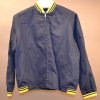 |
Jacket |
This late 20th-century boy's navy jacket has a zip front. The collar, cuffs, and bottom hem feature a yellow-and-navy striped knit pattern. The fabric is a polyester/cotton blend. |
2012.3.1 |
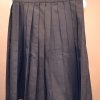 |
Uniform Skirt |
This girl's navy pleated skirt is part of a school uniform. The skirt has a back zipper (pulling from the seam), and is missing either a button or a clasp at the waist. The fabric is a cotton/polyester blend. This skirt is part of a "sailor fuku," a common style of uniform worn... |
2012.3.2 |
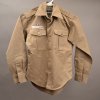 |
Boy Scout Uniform |
This khaki-colored outfit is part of a Boy Scout uniform. The two pieces of the uniform include a pair of shorts and a long-sleeved shirt, both made of a cotton blend. The tag on the shirt is in Japanese and translates to "Boy Scout Association of Japan." The shirt has two breast pockets with... |
2012.3.3 |
 |
Jacket |
This navy letterman/varsity jacket is made of velour with a navy-and-white striped knit collar, cuffs, and hem. There is a zip front and a gray satin interior lining, as well as two pockets. A label reading "Paradise, Made in Vacation" with a fish and a number is on the inside collar. There is... |
2012.3.4 |
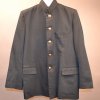 |
Uniform |
This boy's high school uniform, also known as gakuran, includes two pieces: a jacket and gray wool pants. The jacket has a mandarin collar, five brass buttons down the front, two brass buttons on each sleeve, and three pockets. There are two labels, one in Japanese and one in English.... |
2012.3.5 |
 |
Uniform Pants |
This pair of pleated pants is part of a boy's high school uniform, or gakuran. The pants are blue and made of a wool blend. There is no waistband, but they have two front pockets and two back pockets (one with buttons). They are creased in front and cuffed at the bottom. Traditionally... |
2012.3.7 |
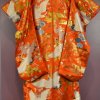 |
Wedding Kimono |
This red silk wedding kimono is called an uchikake. The kimono is decorated with a crane and flower design. Because cranes have long life spans, they have come to symbolize long life and good fortune, making them an ideal symbol for a marriage. This kimono ... |
2012.4 |
|
|
Furisode Kimono |
This furisode (long-sleeved/"swinging sleeves") silk kimono is intended for a young, unmarried woman to wear to a coming-of-age celebration or other special occasion. It is made of ivory silk with a pattern woven into the fabric and a batik-like floral decoration. There is a... |
2012.6.2 |
|
|
Furisode Kimono |
This silk furisode (literally "swinging sleeves," a long-sleeved kimono) is for a young, unmarried woman to be worn for a coming-of-age celebration or other special occasion. The kimono has an ivory background and features nature and landscape scenes: flowers, water,... |
2012.6.4 |
|
|
Uchikake |
This silk wedding kimono (uchikake) has long sleeves (furisode). It was made by the company Hayashi Kimono, whose name and logo are on a paper tag attached to the garment. It has a cream-colored background with a textured pattern of birds (perhaps cranes or pheasants... |
2013.4.1 |
 |
Jacket |
This pale silk kimono-style jacket features a three-inch edging of orchid silk and a pale blue lining. The jacket is embroidered with small black and white cranes in flight, scattered over the garment. Cranes are symbolic of long life in Japanese culture. |
AB 1 1002 c S3 |
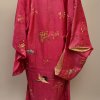 |
Wedding Kimono |
This cherry-colored silk wedding kimono (uchikake) is embroidered with flowers, cranes (tsuru), and butterflies scattered throughout the entire kimono in white, pale pink, chartreuse, gold, blue, and gray. Due to their long lives,... |
AB 1002 s1 |
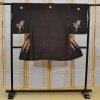 |
Haori Coat |
This haori (traditional coat) is intended to be worn over a kimono. The jacket is knee-length and reversible. The haori is black on one side with wisteria blossoms painted on both sides of the sleeves in yellow and orange; the leaves are green and maroon. The front... |
AB 1007 |
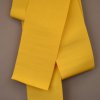 |
Obi |
This yellow woven, synthetic satin fabric obi is an example of a han-haba obi or half-width obi, a more informal sash that is worn casually with summer yukata. This obi is sewn over a stiff lining. The han-haba obi is very popular in Japan... |
AB 66-5 a |
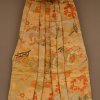 |
Hakama |
This pair of men's hakama (pants) was meant to be worn during a theatrical performance such as Nō. They have straps for tying at the waist and are decorated with floral and drum designs that are scattered over a tan silk ground, embellished with gold, teal, orange, and black... |
AB 76-103 |
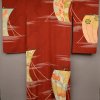 |
Kimono |
This kimono is a deep brick red, patterned with pale blue, orange, and white sail boats. It has a red lining. The silk is woven with a flying geese and wave motif. Red linings fell out of use in the 1950s, so this kimono predates that time. The kimono is a... |
AB 76-132 |
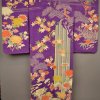 |
Kimono |
This kimono is made from purple silk and features red, orange, yellow, green, and white chrysanthemums and clouds. It has a red lining, and there are bamboo, cherry blossoms, and other flowers woven into the silk. Red linings fell out of use in the 1950s, so this kimono ... |
AB 76-133 |
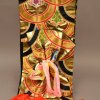 |
Obi |
An obi is a sash for a kimono, traditional Japanese dress. There are many types of obi, which are categorized by their design, material, and use. A tsuke obi, or ready-tied obi, is typically much shorter than other types of obi. With... |
AB 76-138 |
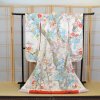 |
Wedding Kimono |
This uchikake, or wedding kimono, is made of an off-white colored silk that is hand-embroidered with a sakura (cherry blossom) design in red, teal, gold, blue, and white. It has a red lining. The kimono is a Japanese traditional garment. Kimono... |
AB 76-53 |